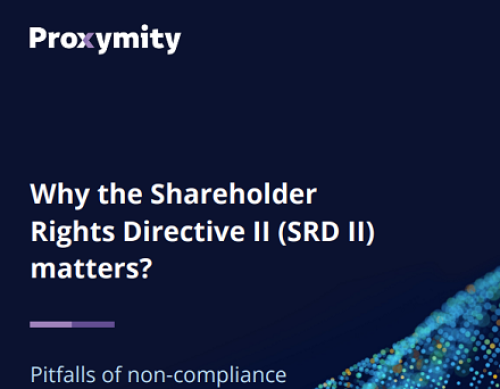The SEC on August 6 approved Nasdaq’s proposed board diversity rules. The rules require Nasdaq-listed companies to disclose annually statistical information on board diversity using a standardized board diversity matrix.
The rules also require companies to have or explain why they do not have at least two diverse directors. To assist companies in identifying diverse directors, the SEC also approved rules that provide Nasdaq-listed companies with access to a variety of board recruiting services at no cost for a limited time.
The rules apply to nearly all Nasdaq-listed companies, including smaller reporting companies and, with some accommodations for home country requirements, foreign private issuers. The rules provide limited exemptions for companies such as asset-backed issuers and special purpose acquisition companies listed under Nasdaq IM-5101-2.
Companies with five or fewer directors can satisfy the board diversity requirement by adding a single diverse director without becoming subject to the requirement to have two or more diverse directors.
The requirement to disclose board diversity factors using the Nasdaq matrix will become effective on the later of August 8, 2022 or the date on which the company files its proxy statement or information statement for its annual shareholders meeting during calendar year 2022 (or, if the company does not file a proxy or information statement, the date on which it files its Form 10K or 20F annual report).
A Nasdaq FAQ published on August 13 states that a company that files its 2022 proxy or information statement (or its Form 10K or 20F) before August 8, 2022 and does not include the Nasdaq matrix will have until August 8, 2022 to disclose its matrix. The company can make this disclosure either on its website or in an amendment to its annual report, such as on Form 10K/A or 20F/A.
The requirement to have or explain the lack of diverse directors becomes effective in two steps: August 7, 2023 for one director and August 6, 2025 (August 6, 2026 for companies listed on the Nasdaq Capital Market) for two directors. A Nasdaq FAQ states that if a company files its proxy or information statement (or, if the company does not file a proxy or information statement, in its Form 10K or 20F) for the company’s annual shareholders meeting after the applicable effective date noted in the previous sentence during that calendar year, then the company will have until the date it makes that filing to meet, or explain why it does not meet, the applicable diversity objectives.
The Nasdaq website has additional information available on the rules, including effective dates for the board diversity disclosure rule and the board composition rule.
Corporate governance landscape
Board diversity, reflected in terms of gender and other factors such as racial and ethnic background and sexual orientation, is one of the most visible corporate governance topics today. The rules are part of an expanding web of diversity initiatives and influences that public companies and their boards must navigate.
Proxy advisory services such as ISS and Glass Lewis have adopted policies that take account of board diversity. Leading institutional investors, including BlackRock, State Street, Vanguard and CalPERS, have adopted various disclosure and voting policies that support board diversity.
Goldman Sachs Group announced in 2020 that it will only underwrite IPOs in the US and Europe if the company has at least one diverse board member, and that starting in 2021, it would raise this target to two diverse candidates for each of its IPO clients.
Some US states, most notably California, have adopted laws that require companies to have directors who are diverse, based on gender and/or status as an underrepresented minority or sexual orientation. In the absence of a mandate from the US Congress, the SEC’s actions in this area have been limited to interpretive clarifications that existing disclosure requirements under Item 401 and Item 407 of Regulation SK include some aspects of board diversity.
In light of the current corporate governance landscape, many publicly-traded companies were already focused on board diversity. Given the approval of the rules by the SEC and the relatively short period of time to plan for the impact of the disclosure requirement on 2022 proxy statements, Nasdaq-listed companies should review the rules and, to the extent that they are not already doing so, consider acting promptly on the actions set forth below, where necessary.
What companies should be doing now
- Plan for board diversity disclosure in 2022
Nasdaq-listed companies should be planning for the impact of the Nasdaq-prescribed board diversity matrix disclosure. Companies that file the proxy statement for their 2022 annual meeting of shareholders before August 8, 2022 can defer the board diversity matrix disclosure until August 8, 2022, which is the latest date to post this disclosure on the company’s website or file an amendment to the company’s Form 10K or Form 20F annual report.
Companies that file the proxy statement or information statement for their 2022 annual meeting of shareholders on or after August 8, 2022 must include the board diversity matrix disclosure in the proxy or information statement when filed, or in a Form 10K or Form 20F annual report filed during calendar year 2022 if the company does not file a proxy or information statement.
Although the rules permit companies to publish this information on their website, we anticipate that many domestic Nasdaq-listed companies will provide this disclosure in their proxy statements in order to respond to the diversity mandates of institutional investors, proxy advisory services and others.
Companies that have not provided board diversity disclosure in the past should start thinking about how they will provide such disclosure in 2022 and future years. Even Nasdaq-listed companies that have provided board diversity disclosure in the past will now need to consider how to provide such disclosure using the Nasdaq-prescribed matrix.
- Update D&O questionnaires for diversity characteristics
Companies will need to navigate the best way to determine the diversity characteristics of directors. The most common way to obtain diversity characteristics of a company’s directors is through the D&O questionnaire. Companies that intend to do so should review and, if necessary, revise their D&O questionnaires. The Nasdaq-prescribed diversity matrix is a good starting place as companies review any changes in their D&O questionnaires, even for companies that are already soliciting board diversity information through their D&O questionnaires.
For example, it is likely that many D&O questionnaires do not include a method for directors to self-identify their gender as ‘non-binary,’ which is among the gender identities required in the Nasdaq matrix. Note that the rules apply only to directors, and do not apply to the company’s management or its employees as a whole.
- Identify, recruit and appoint diverse directors
The rules require Nasdaq-listed companies that do not have at least two diverse directors by the prescribed compliance date – including one who self-identifies as female and one who self-identifies as either an underrepresented minority or LGBTQ+ – to explain why they have not done so. Even though the rules have deferred effective dates and transition periods, Nasdaq-listed companies that have not already begun to do so should begin to identify, recruit and appoint diverse directors now.
As discussed above, public company boards are already under a broad range of pressures to diversify board membership. The rules add a potentially significant new pressure that could ultimately result in Nasdaq delisting a company if the company continues to fail to comply with the rules. Nasdaq-listed companies will want to be prepared to meet the requirements of the rules and thereby avoid adverse disclosure about their lack of board diversity.
- Impact on boards and shareholder voting
As a result of the rules and the evolving corporate governance landscape, it is likely that public company boards will continue to become more diverse. In this regard, we anticipate that most Nasdaq-listed companies will choose to have the requisite number of diverse directors within the required time frame.
It is also likely that institutional investors will continue to use their votes at annual meetings to indicate their displeasure with boards that are not diverse. Proxy advisory services are also likely to increasingly scrutinize board diversity and issue adverse voting recommendations for directors at companies that do not have diverse boards.
- Potential legal challenges to the rules
Companies should be aware that private sector organizations have already expressed their intent to challenge the rules through litigation that will seek to delay, modify or overturn the rules on various grounds. There are recent precedents involving litigation that challenged SEC disclosure requirements for conflict minerals and resource extraction payments. These lawsuits resulted in years of delay and ultimately significantly altered the disclosure requirements originally adopted by the SEC.
Although predicting the ultimate outcome of this anticipated litigation is impossible at this time, board diversity is clearly a serious consideration for public company boards that is only likely to continue to grow in significance.
- Not just the rules
Regardless of the outcome of any legal challenges to the rules, the rules are part of a broader range of pressures that seek more diverse board membership. These pressures come from institutional investors, financial markets, legislative bodies and a variety of social commentators. Companies should begin to take steps now to address board diversity, including by taking actions to respond to the requirements of the rules.
Sean Donahue is chair of Goodwin’s public company advisory practice, and John Newell is counsel in Goodwin’s public company advisory practice
This article was originally published on the Corporate Secretary website.










